E-commerce business owners live in a rabbit hole: with an average conversion rate of 3 to 4%, they are either always busy chasing a new customer or going out of business.
The unpleasant cost of pursuing a new customer — especially, as opposed to keeping an old one — only further compounded the problem. But if all e-commerce businesses are mired in this problem, no e-commerce business would exist today.
For the most part, they aren’t. A lot of e-commerce brands are thriving and pushing boundaries.
They just aren’t doing it by chasing after customers every time. They have enough time to make their businesses better. And that is because they have enough paying customers to keep them in business.
How do they do this?
It’s simple. They do things that make their first-time customers buy more. In other words, they make a lot of returning customers out of their random buyers.
And when you look at the index of all businesses that rule the world today, you’d find that the commonest denominator amongst them is their monopoly-like ability to get random buyers to buy more. Think Saas companies such as Bluehost and subscription-based businesses such as Netflix.
In this post, I want to show you, with examples, how you too can win over your first-time buyers and get them to buy more.
Set up a virtual “Help Us to Serve You Better” interview
What is the difference between serving a buyer a welcome email and immediately showing them something else to purchase without first welcoming them? Hardly any.
A brand that sends a welcome email thinks it’s being nicer than the one venturing to call newcomers to buy more right away. To me, neither of them is better because they are both heading in the same direction, and the jaded consumers are mature enough to see it for what it is.
You’ll only stand a chance if you can go overboard and do the extraordinary that makes you stand out. In this, there is something you can learn from my experience with Udemy.
Once I purchased a real estate investing course on Udemy, I was led to a virtual interview page.
With each page I get to, questions that are important to my learning journey were asked. Questions such as “Why are you learning this course” and “How familiar are you with the topic?” with the suggestions that came with them quickly communicated to me that they were out there to make life easy for me.

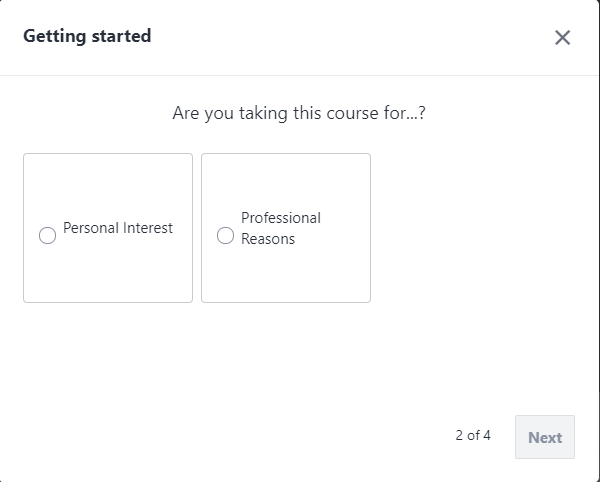
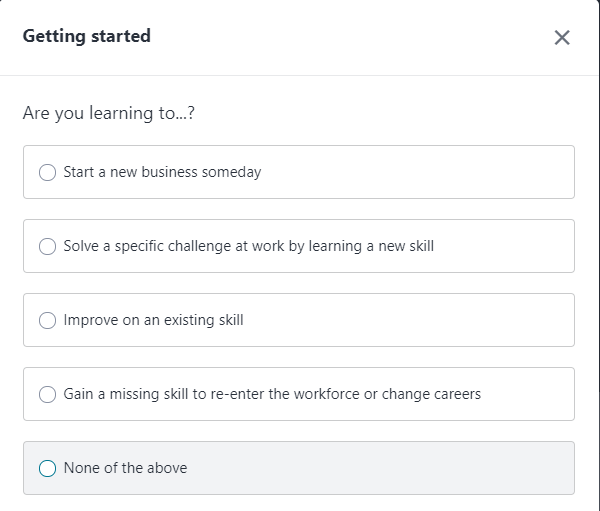
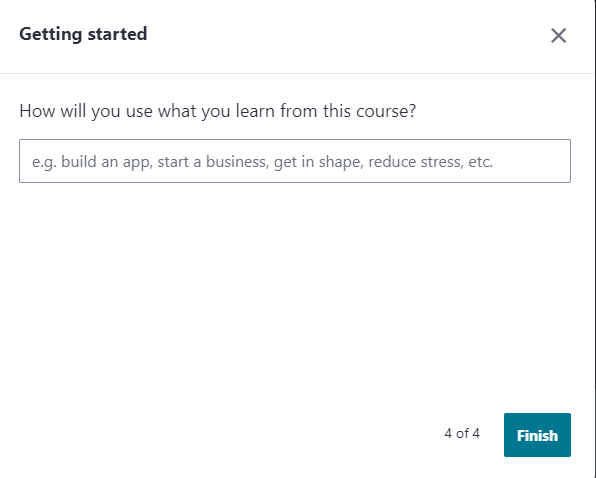
By the time this virtual interview was conducted, I had already purchased the course, and by these simple questions, they demonstrated to me that I wasn’t about to be taken to a class of knowledge in which I didn’t belong.
When I saw that they were asking me why I had purchased the course, whether I wanted to build a new business or change a career or get a promotion, I knew to take them seriously.
What they did or did not do after that is a discussion for another time, but the realization had already hit me: I needed someone who knew where exactly to take me to and Udemy proved they are that someone.
But this has even a more far-reaching effect: I looked forward to each of their emails and browsed through as they suggested courses that could complement what I was learning, and that was because the virtual interview has primed me for that.
When you apply it to an ecommerce store, the effect is universal.
If you want to give your customers a great post-purchase experience, create a rapport by showing them you care for them.
Apparently, not everyone has something to do on your website after their purchase. But you can send them a link to the virtual interview in your welcome email, using simple survey tools like Google Forms or Hubspot customers’ feedback software.
A finding by GetResponse shows that welcome emails have an 82% average open rate. Don’t waste it trying to say thank you for buying.
Create an omnichannel support system
Americans tell an average of 15 people about bad customer service and an average of 11 people about a good one, Kinsta reports. Meanwhile, 96% of consumers from across the globe are saying customer service is an important factor in their choice of loyalty to a brand, according to Microsoft.
And what is customer service? Simply, access. “Digging into e-commerce statistics,” Kinsta says, “the key to good customer service is making everything as easy as possible.”
If this wasn’t so, I’d be using an entirely different web hosting service for my site today.
As a first-time website builder, I had a serious problem setting up my website right. When I got to the website of my hosting company, Bluehost, a live chat button was waiting for me on the homepage.
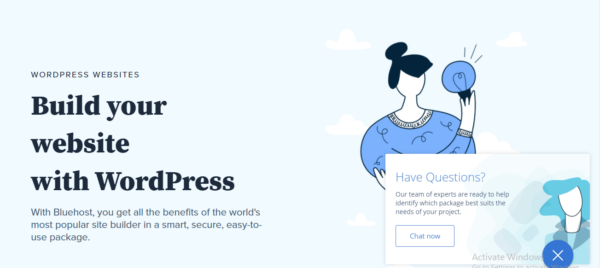
When I clicked on it, it was everything it promised and more: an easy-to-use live chat tool and a responsive agent asking with all genuineness what my problem was, and answering me with a motherly reassurance that they are not leaving until the problem is solved.
Call it a royalty treatment if you like. But that’s the dream of every customer. Nothing delights like the feeling of relief that descends on you after the thought of having lost your dollars on the wrong product fades.
And again, this is no rocket science. Consumers just need easy access and a reliable customer care representative.
To do this well, implement as many as possible of the four things below, and see how you turn your first-time customers into raving fans.
Set up a live chat on your website
If you are not short on budget, set up a live chat on your site. This allows your customers to discuss their problems with you in real-time.
It also helps you to gauge their experience using your product. And make it immediately visible on your site, as you have seen with the example of the Bluehost homepage above.
Software like Livechat allows you to set up a quick live chat platform that fuels customer satisfaction.
It is also an avenue to get real-time feedback from your customers.
Set up an effective email support channel
A live chat platform is a great option, but an easily-found and responsive customer support email address is an almost-equally-good alternative
And once you set it up, set up an auto-responder to ensure that no customer is left in doubt as to whether their email got to you or not.
Your auto-responder message should convey to them that you got the email, and also tell them how long it will take before you can respond. The best auto-responders also come with a ticket notifying the customer that their issue will be attended to sooner than later.
By so doing, you take the limbo and the doubt out of it for them.
Here is an example of an auto-responder message with a ticket.

A prompt response will calm the nerves of an annoyed customer, even if the situation could not be resolved. But a company that responds promptly to the needs of its customers and still resolves their issues will have a special place in their hearts.
Lucky for you, email ticketing automation tools like Zoho Desk make this easier done than said.
Create a chatbot
When millennials, the generation with the highest purchasing power, say they prefer a chatbot support channel, you can no longer ignore it. But chatbot is actually popular among all types of consumers as more than 60% of them say they prefer digital self-serve tools like chatbots.
This is not so different than setting up a customer support email address, but a lot more advanced.
But there is substance behind this popularity. Chatbots can help book meetings for your representatives, link to self-service articles, and can be integrated with a complete ticketing system.
Chatbot apps such as Hubspot will allow you to build one for free. But if you are looking for something more advanced, you can check out Bold360 and several other alternatives.
With a chatbot, if a consumer comes to your website trying to complain about something, a bot that invites them for a talk will save them from confusion and foster trust between you and them.
Be responsive on social media
That should go without saying. But for the record, 35% of your consumers will try to use it to reach out, that’s according to MTD.
There was a time when Facebook branded business pages based on how responsive they were. Brands took advantage of it and wore it like a badge of honor.

But it shouldn’t take a badge for any business owner to know how important it is to be responsive on social media — in a social media world.
Needs are cyclical. When you show your customers that you are always ready to listen to them, you give them a reason to come looking for you when next they need to shop for something.
The bottom line is for you to give your customers the needed confidence to always come back to you in their times of need — whether that’s on social media, or via an email, or through a chatbot.
Be particular about your refund policy
A refund policy can also be loosely referred to as a Money-back guarantee. Of all the guarantees in the world, it’s the most popular one. And as Neil Patel said, it’s becoming overused.
But it seems to have an effect on making a buyer stick to you a little bit longer.
According to Invespcro, the following are true:
- 92% of shoppers say they will buy again if the return process was easy
- 79% of consumers expect free return shipping
- 27% of shoppers would purchase an item that costs more than $ 1,000 if it offered free returns
I agree; maybe not all of those are relevant to you in particular, but there is one that actually struck me: a whopping 92% of shoppers say they will buy again if the return process was easy.
Well, this should not come as a surprise.
After purchase, consumers are either going to experience one of these three emotions: satisfaction; dissonance; dissatisfaction.
If you make it clear that they can always return the product within a given time, then you subconsciously plant it into their hearts that they can trust you.
And when someone becomes sure that their money isn’t going anywhere until they get the value for it, you become their first-in-line for the same or similar products.
Refund policy is a simple and understandable concept. But you have to go overboard to make them see that you have it. If your product is good enough, most consumers may not need to return it, but the very presence of it builds trust and reliability.
You know we will all buy only from a brand we can rely on.
Take it from Rebel Girls.
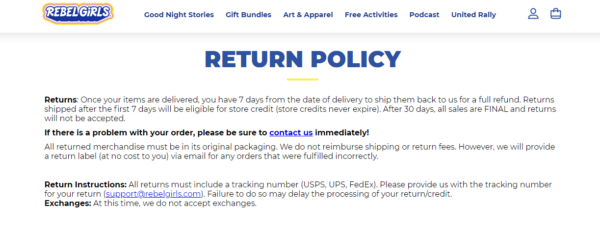
But Rebel Girl did not stop at that. They put it on their navigation to ensure you can easily find it.
But you can even take it a notch higher by involving it in an email you send to them after their signup.
Do not forget to extend the return time limit as much as possible.
Of particular interest, in this case, is Brummel which has not more than three items on its footer navigation, but made Refund Policy one of them.

And then goes on to give you a 30-day window return policy.
Do this, and see how your customers stick to you in droves.
Create an online course to help your customers
Salesforce, MarketingProfs, Neil Patel: these guys have access to the latest data. And that’s just one of the many reasons we need to pay attention to what they do.
Salesforce, the renowned enterprise solution has been offering courses to customers and prospects long before it became fanciful to do so. Salesforce uses online courses to promote the products in its product line depths.
MarketingProfs is also known for doing the same thing; they invite you to buy courses and introduce you to more products that can improve your bottom line. If these big brands are doing it, then it, most assuredly, is working.
And in recent days, we see Neil Patel step up with offering free courses as he works hard to grow his SEO tool, Ubersuggest.
Why are they all doing this? Maybe if we look at the numbers, we will understand.
According to On24, a webinar hosting platform, online training, and continuing education jumped by 11% and 22% respectively in 2020 while Guide2Research is reporting that MOOCs are rising year on year.
The lesson? More people are seeking education online, or maybe people are seeking online education more; whichever the case may be, an online class is a great avenue to upsell or cross-sell your new customers.
Depending on your budget, you can create free courses using Udemy and invite them over. Or you can host your course on independent online learning platforms.
Develop a customer loyalty reward
Research has shown that 52% of customers will join a loyalty program if one is offered them. What, however, remains under debate is whether it is cost-effective.
But when you see the numbers of average conversion rates an e-commerce business should expect, you’d understand that 52% of customers joining your loyalty program is not supposed to result in a loss.
Of course, in your own case, not all the 52% will join. Or maybe a lot more would. And most certainly, not all the 52% who join will use their loyalty program.
But if you succeed in making a vast majority loyal, you succeed in blocking what would probably end up as a leaking hole in your sales bloc. And research supports this. A study by Invecrospo shows that a 5% increase in customer loyalty would increase the average profit per customer by 25%-100%.
The study gets even more interesting when we find out that 58% of respondents say they buy from stores and brands whose loyalty program they belong to, at least, once a month.
Discard the rest of the stats and think about that for a moment. A random buyer who accidentally landed on your store turns to someone that buys from you every single month, saving you an additional cost of finding a new customer.
That’s insanely profitable, no matter where you look at it from.
When it comes to loyalty reward programs, examples abound. As you are the owner of your business, you are in the best position to decide which will work in the best of your interest.
A brainstorming session with a number of smart men in your team will certainly help in this, because from industry to industry and brand to brand, plenty of examples of brand loyalty reward programs exist.
You can learn from Starbuck. You can learn from Uber. But ultimately, you’ll have to find something that works nicely for you better than the next brand.
Conclusion
Little numbers move industries, whether conversion rates or email open rates or clickthrough rates.
When you look at them, the numbers are usually not sexy, yet they make things happen.
If you’ll succeed, you need to leverage what you’ve got very well. In this case, it is about increasing sales by delighting your customers.
And I need not mention that the list of things I mentioned above is not exhaustive, not even anywhere near. But they are enough to open your mind to greater things. They can be further tweaked, refined, and taken beyond known limits to make miracles.
But do any of those and you’ll be fine.
Digital & Social Articles on Business 2 Community
(136)



